One of the things that’s new about the just redesigned Ram 1500 is that if you want a regular cab, you’ll have to buy the old Ram 1500 – which will be sold alongside the new one under the “classic” label, like Classic Coke.
The new Ram comes only in four-door form – at least for the moment. But that moment may last for awhile. The two Rams are built in different places, using different tooling – and each appeals to different buyers.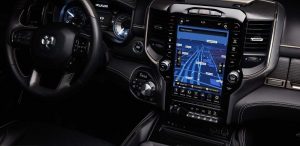
Regular cab big trucks are bought for mainly hauling things. A stack of 4×8 of sheetrock; a pallet of bricks. Four-door trucks are bought mainly for hauling people – and maybe pulling something (like a an RV trailer or a boat).
So, we have a Tale of Two Rams.
WHAT IT IS
The Ram (formerly Dodge Ram) is FiatChrysler’s half-ton truck, which means it’s a 1500 series full-size truck and can carry up to . . . half a ton (1,000 lbs.) of cargo.
1500s are are still considered “light duty” – vs. three-quarter ton and heavier-duty trucks – but are only that in comparison with the 1500s of the past.
Or at least, 1500s that aren’t Rams.
This “1500” can actually carry as much as 2,300 lbs. – just 200 lbs. shy of what defines a 2500 series truck . . . well, used to.
It can also tow just shy of 13,000 lbs. – which in truck terms is a metric comparable to getting to 60 in less than three seconds, if we were talking high-performance sports cars.
Actually, we’d be talking about a supercar in that case.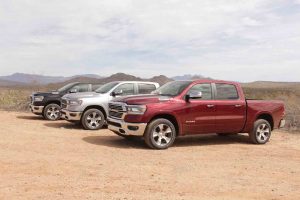
The new Ram is sold in many configurations – as 1500s have traditionally been sold – to meet almost any conceivable buyer need and desire.
What’s not traditional is that Ram is selling two versions – the New and the Classic.
The new Ram – which is completely redesigned – is available in four-door form only (Crew and Quad) in an almost unlimited number of trims (base Tradesman, Big Horn, Long Horn, Rebel, Laramie, Limited) in short and long wheelbase form, rear-wheel-drive or four-wheel-drive, and with short and long beds, too.
Or you can buy the old Ram – it’s being sold alongside the new Ram – if you want a regular cab, less “stuff” – and a lower sticker price.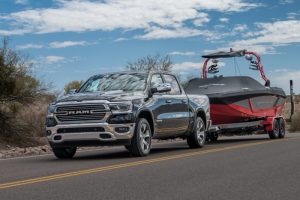
The base price of the new Ram is $31,695 for a Quad Cab Tradesman trim with a 3.6 liter V6 and rear-wheel-drive. A Crew Cab, long-wheelbase Laramie trim with 4WD and the 5.7 liter Hemi V8 stickers for $57,690.
The old Ram – which is still technically new, too – is available with two doors and a much lower sticker price: $27,095 for the base Tradesman trim with V6 engine, rear-wheel-drive and a six-foot bed. But it doesn’t get the new Ram’s numerous updates – and there’s some good there, too.
The Ram 1500 ’s main competitors are the Chevy Silverado 1500, the Ford F-150, Nissan Titan and Toyota Tundra.
WHAT’S NEW
Everything – unless you go Classic – then it’s the same as before, just a 2019 instead of a 2018. 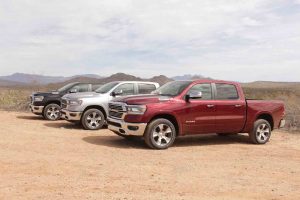
The new Ram gets a through cosmetic and mechanical makeover that includes an eTorque “mild hybrid” set-up for both of its available engines; it replaces the conventional alternator with a high voltage (48 volt) belt-driven motor-generator rig and battery pack that adds torque on demand, provides electricity to power accessories and makes the auto-stop/start system more seamless by making re-starts almost instantaneous.
The system is designed chiefly to improves the fuel economy of both engines – which enables Ram to continue offering these traditional, large-displacement engines instead of much smaller (and heavily turbocharged) engines – as both Chevy and Ford have resorted to doing – in order to avoid “gas guzzler” fines levied by the government for falling short of Corporate Average Fuel Economy mandatory MPG minimums.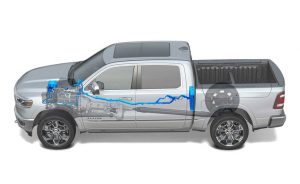
There’s also 4G wi-fi, available reclining rear seats, a 12-inch touchscreen and a 900 watt, 19 speaker Harman Kardon audio rig among the new Ram’s roster of high-end amenities – as well as a new three-piece/folding tonneau cover for the bed.
WHAT’S GOOD
New Ram’s cab (four inches longer than before) is roomiest in class.
Long bed is still available with both Crew and Quad cab configurations.
Standard Ram engine is still a hunky V6 – not an undersized turbo four.
Best in class tow/payload rating.
WHAT’S NOT SO GOOD
Crew/quad cab configuration with an eight-foot bed is a long-legged mack daddy.
More manageable regular cab configuration only available with “Classic” Ram.
Mild hybrid system adds noticeably to the new Ram’s sticker price – and may add noticeably to down-the-road repair costs.
These are radical times – and we’re seeing radical engineering solutions to cope with them.
Ram – FCA, really – has come up with a different solution, too. Instead of resorting to downsizing engines – and then turbocharging smaller engines, as both GM and Ford are doing with their 1500 series trucks – FCA is trying to keep big engines in the lineup by hybridizing them.
Both the standard 3.6 liter V6 and the optional 5.7 liter V8 are paired with what FCA calls eTorque – a mild hybrid system that doesn’t (as in less-mild hybrids) actually propel the truck per se but does amp up the electrical power available to power accessories that would otherwise have to be be powered by the running engine – and a running engine runs on gas.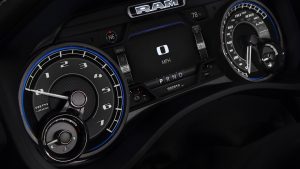
It also much-improves the operating characteristics of the auto-stop/start system the Ram – like almost all new vehicles – comes standard with. The 48 volt belt-driven motor-generator is much faster than the 12V gear-driven starter usually used to spin an engine back to life – so the stop-star sequence is almost invisible now. That means no more having to remember to turn off the auto-stop/star system to avoid all that very visible stopping/starting.
The 12V starter motor is still there, too.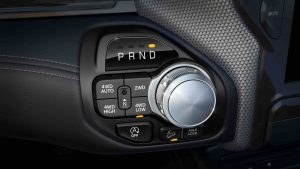
But it’s only used for initial cold start. This should mean a longer life for that starter. It’s also a way to address another auto-stop/start problem: Shortened battery life. The 12V batteries used to start car engines for the past 50-plus years were not designed for all this stop-starting. They were designed to start the car once, so you could drive for awhile. As you drove, the engine – via the alternator – fed charge back to the battery, “topping it off” so it would be charged up and ready for the next start.
But with auto-stop/start, the battery is tasked with restarting the engine perhaps dozens of times each time you drive – and there’s less time in between to recharge it fully. And the heavier discharge/recharge cycling wears the battery out faster, too It also makes the alternator work harder trying to keep the 12V battery up to speed for work it really wasn’t designed to handle.
The motor-generator rig and 48V battery address that issue, but there is the potential issue for expensive 48V battery(and motor-generator) replacement at some point down the road.
The eTorque set-up also provides an on-demand torque boost of 90 ft.-lbs. for the V6 and 130 ft.-lbs. for the V8 – although Ram does not count this when advertising the power output of either engine. The claimed output of the 2019 V6 is 305 horsepower and 269 ft.-lbs. of torque – same as the 2018 version of this engine without the eTorque assist. Same story for the Hemi V8, which rates the same 395 horsepower and 410 ft.-lbs. of torque as the 5.7 V8 in last year’s Ram.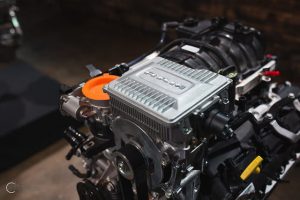
There’s supposed to be a mileage uptick – but according to the Ram media kit, the 2019 version of the Hemi with the eTorque system delivers 15 city, 22 highway – which is also the same as the 2018 V8 Ram.
There’s got to be a gain somewhere – though it may only be on the tests the government requires new vehicles to pass in order to be “certified.” And it may not be mileage as much as emissions – now that the EPA is counting carbon dioxide (which has nothing to do with air quality) as an emission. The eTorque system has the potential to keep both engines off a little longer – and that is the only way to reduce carbon dioxide “emissions.”
That said, I averaged 19 MPG in a Semi-Equipped 4WD Quad Cab – which is the most thirsty version of the Ram. That’s very good mileage for a 1500 Quad Cab with a big V8 and 4WD.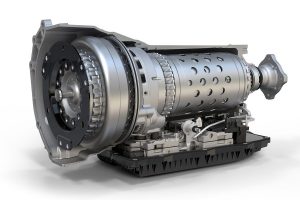
Performance is better, too – and not just because of the torque boost provided by the electric motor-generator. The new Ram weighs about 225 pounds less than the old (and “classic”) Ram. The tailgate’s aluminum – which makes it much easier to open and close, too – and the Ram’s new, higher-strength frame is 100 pounds less heavy (but not less heavy-duty; check the tow/payload stats) Less weight – plus more power (even if not advertised) equals quicker – or ought to.
Official numbers weren’t available when this review was written in late October but given that the old (and “classic”) Ram with the Hemi ran to 60 in about 6.4 seconds, depending on the configuration, the new one should be at least a tenth or three quicker.
Same as regards the V6-equipped 2019 Ram.
Both versions use an eight-speed automatic, as before – but it’s been updated for more efficient operation.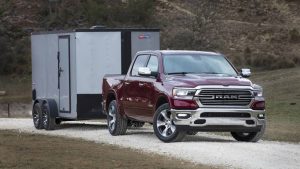
Another update is a heat exchanger that warms up the gear lube – which reduces friction on cold days and that ought to reduce wear and tear over time.
A locking differential is available on all trims, with either engine.
The Ram can pull a staggering 12,750 lbs. and carry 2300 lbs. of payload. Those numbers edge of the Ford F-150 (12,000 lbs., max) and the Chevy Silverado 1500 (12,200 lbs.)
It even out-tows the Nissan Titan XD – which is a heavier-duty truck than a 1500 and closer to a 2500 – and has a turbo-diesel V8 and 500-plus ft.-lbs of torque.
But even it maxes out at 12,310 lbs. of tow capacity.
The Ram – like all current 1500s – is a study in contrasts. The thing is huge – especially now that the new Ram comes in mandatory four-door configuration. You can equalize that out somewhat (lengthwise) by opting for a short rather than a long bed, but even so the thing is big.
And, tall.
You literally climb aboard – if you’re not used to new trucks, you may expect an oxygen mask to drop – and look over a bulging hood (Hemi Rams) with four vented scoops. All that’s missing are the pop-up .50 cals to blow away any Prius that gets in your way.
Which you might need, because the Ram – like all current 1500s – uses every inch of pavement in between the painted lines. It is 82.1 inches wide – which is almost a foot wider than a current mid-sized car like the Toyota Camry (72.4 inches wide).
Parking one of these behemoths requires skill, too – and even if you’ve got it, there’s often simply not enough room to do it without a lot of inching forward and back – because parking spots are car-sized and that’s about half to two-thirds the size of this rig.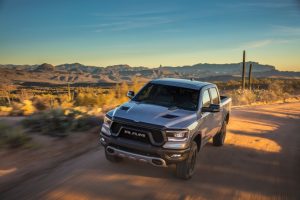
That said, once you have climbed inside – and have wriggled free of the confines of curbside parking – driving this thing is as enjoyable as it’s got to be running an aircraft carrier at 40 knots on the open sea.
Light, precise steering. Bottomless power from the mighty Hemi.
It even corners – which isn’t all that surprising when you reflect that a current 1500 series truck rides on a frame and a suspension system not much different than what you’d find under some classic-era muscle cars, like my ‘70s Trans-Am. Sold axle, coil springs – plus much better (bigger) tires, which compensate for everything being jacked up.
I hustled the Laramie Quad Cab through a series of S curves at Bent Mountain – my local informal test track – at speeds higher than my Trans-Am can handle – and my Trans-Am generated better skid pad numbers than the Corvette, back in the day.
Not that the Ram can joust with new Corvettes. Do not try this. But the point is that today’s trucks are that much better than yesterday’s in terms of not handling oafishly. Of being capable of easily handling high speeds – and curves at high speed – that were dangerous in trucks as they used to be.
Handling and road manners are enhanced by the Ram’s available load-leveling air suspension and “frequency response damping” shocks such that even riding on 20-inch wheels with short sidewall tires, the Ram has better road manners than my TA – and right up there with a new Camry, too.
Just three times the size.
Ram – when it was Dodge (and Ram was the name of the truck, not the brand) was the first to really commit to mucho macho styling when it came out with the Kenworth-inspired Ram.
That got the ball rolling.
Ford upped the anted up with its Super Duty-themed F-150. Chevy bulged and beefed the Silverado in reply.
American sedans were once known for their bigness -and their ballsy styling. Today’s American cars are mostly metrosexual looking clones of front-wheel-drive imports and definitely not big – especially under the hood. Federal fuel efficiency regs are responsible for that – and trucks like the Ram and its rivals are the reaction to that. Think about the Cadillacs and Lincolns of the ’60s and ’70s . . . the Ram is the modern era’s expression of the same ideal.
It is about living large – literally and metaphorically.
Pruis people are appalled by trucks like the Ram – and that is precisely the source of their charm. To own one is like being rich enough and powerful enough to say something politically incorrect in public – and not have to worry about being sent off on a Mea Culpa tour.
It is no exaggeration to say that – in spite of the worst intentions of the government wet rags who have been trying their best to kill big/powerful/stylish American vehicles for decades – the Ram is the ne plus ultra elaboration of the Cadillacs and Lincolns of the ’60s and ’70s.
You can get it with reclining rear seats – those seats covered in perforated and heated leather, if you like. A 900 watt, 19-speaker stereo that can hold its own with an S-Class Mercedes Burmester or Jaguar Meridian rig. Electric/power everything conceivable, including a gorgeous 12-inch touchscreen, 5 USB ports and in-vehicle WiFi.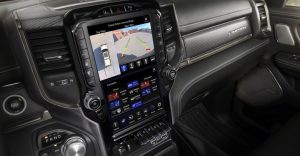
Even a full-length panorama sunroof – just as you’d find in a six-figure luxury sedan.
Only this one happens to have ground clearance, 4WD and can pull the Queen Mary behind it.
THE REST
The Ram used to be sold under the Dodge label but FCA moved all the former Dodge Ram trucks off the Dodge lot and onto a now-trucks-only Ram lot. The reason for that is both good – and bad – depending on your point of view. It’s good – if you like Ram trucks – because the move indicates that FCA sees a future for Ram trucks as a stand-alone brand.
It’s bad – if you like Dodge – because the movie indicates that FCA is separating out the brand (and vehicles) which will survive from those which . . . won’t.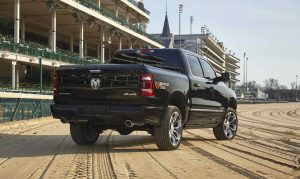
But that’s another story.
THE BOTTOM LINE
For the rest to catch up, they’re going to have turn their 1500s into 2500s. And what happens to the 2500s then?
Ram hasn’t just raised the bar. They welded rockets to it and shot the thing beyond the horizon.
. . .
Got a question about cars – or anything else? Click on the “ask Eric” link and send ’em in!
If you like what you’ve found here please consider supporting EPautos.
We depend on you to keep the wheels turning!
Our donate button is here.
If you prefer not to use PayPal, our mailing address is:
EPautos
721 Hummingbird Lane SE
Copper Hill, VA 24079
PS: Get an EPautos magnet (pictured below) in return for a $20 or more one-time donation or a $5 or more monthly recurring donation. (Please be sure to tell us you want a sticker – and also, provide an address, so we know where to mail the thing!)
My latest eBook is also available for your favorite price – free! Click here. 


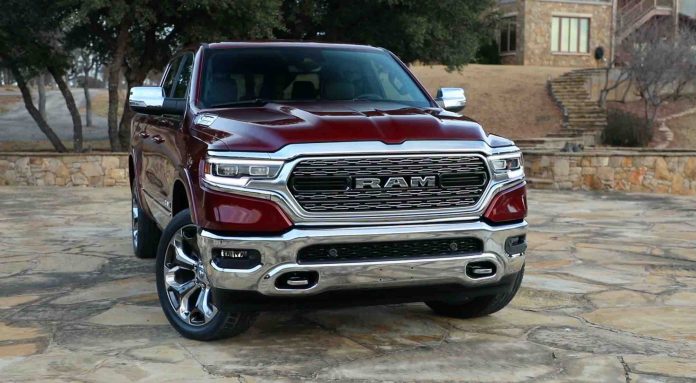


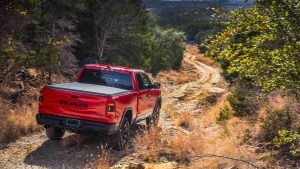
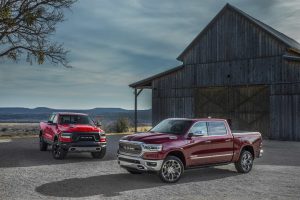
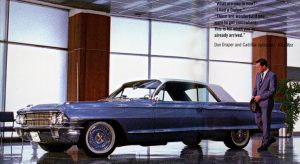









On the RAM website it looks like the mild hybrid system is optional on the V8 engine (standard on the V6 though). So it looks like you can still get the 2019 without it for the time being.
In the oilfield hardly anyone drives a 1500 series, 2500 diesel is what all the guys want.
Hi Seth,
Given that current 1500s are physically as huge as 2500s, I’d want the 2500 also – in order to get the diesel, just as you say.
Yeah BUT, every contractor that we deal with hates the new Tier 4 diesel’s. They say they only go 100K before they are done, when they used to get 300K. Some of them are considering going back to gas. EPA to the rescue! or should I say crony capitalism to the rescue! haha. What’s the environment savings on this train wreck? 2 new engines vs none to get to the same 300K? so stupid.
Keep in mind that they use these trucks as tools, and hammer them every day. One contractor I just spoke with said ‘why not get the gas, save 8K upfront, and then just throw it away at the same 100K miles?’
Big new expense for them (they we ultimately pay for anyway) and they don’t know what to do.
I’ve got gas engines still going strong at a heck of a lot more than 100K miles.
Been seeing more of the higher series pickups in work fleets and with contractors. May be easier to get a non-luxury model, but with the bigger engines, gearing etc. Don’t have to compete with the people buying the 1500’s for their family car……. They start at about $4k more, but most of the things a working truck need are standard, so it may not be all that more expensive if you don’t load on a bunch of options.
Got to love the irony of government regulations ending up putting people into even larger vehicles…..
Have you seen the new C4500 crew cabs?
The SUV of the future – ha!
Not everyone who drives a Prius is a “Prius person”. I was offered a 2007 in pristine condition with 72K miles for 5K. It is perfect for my current situation, 15 – 30 min. commutes rarely over 50 mph. How could I refuse?
But I am definitely not a global warming libtard. Stop picking on us man!
A pickup truck with 12 inch touchscreen, wifi, and panoramic sunroof…. what has the world become…
Well it’s doing double duty. It’s today’s real full size premium car, since none of those have been built since the 1970’s. Unfortunately for those that need a pickup to make a living, the luxury models (bigger profits) are crowding out the working trucks.
So much for the days when a farmer knocked off what manure he could from his boots, jumped into the cab of a pickup smelling of diesel fuel and Roundup, and did some real pickup work. Our wealth has made sybarites of us all.
Hi Ross,
I think we’re agreed that debt – access to excessive credit – is the root of many of the ills which beset us. This includes those of us who avoid debt, because even though we live within (or below) our means, the fact that so many do not acts upon us as a rip tide and carries us along. This truck business is an excellent example. Most people cannot afford these $40,000-plus behemoths but because they are able to finance them, large numbers do so and because of that, the car companies focus on the $40,000 trucks (and similar) and stop building the $25,000 trucks because there’s less money to be made there.
Credit is like crack and that’s no exaggeration.
Many people are vulnerable to becoming hooked on it and the debt mongers know this and leverage people’s weakness to their advantage.
It is ultimately the fault of the person who chooses to buy what he can’t really afford – but it stinks that the rest of us are forced to assume the burdens imposed by him.
Not all of us …
I paid $800 for my current pickup (it needed some work) that I use for cutting firewood and hauling trash to the dump, along with other misc duties.
Let’s just say that I’m not afraid to scratch it – ha!
Barf. A truck should just be a truck, not a VCR on wheels.
So when are they going to come up with a three-row, six door “pickup” with a two foot long bed ?????
And THEN some outfit will build a cab-over camper to fit it!
I need to get my 1976 GMC C-20 rebuilt ……….
Coming from 30 years of GM trucks, because they always innovated, and had the best (IMO) engines, interiors, and suspension, I think I am finally done with GM. I think I had 15 of their trucks. They started to lose me in ’07 when their first 6 speed came out, and I had to have it with the then new 6.2. Wow, it was awesome, fast, classy in Denali trim, BUT the trans shifting parameters were a disaster, I think to save mpg. I couldn’t drive it. Either could many others cause they ‘updated’ the software two times, and it still sucked. Then the GM sucker in me bought an ’11, same-same specs, and it was better, but still not great. Then GM suckered me in again, did it again in ’14, and it was finally fixed, I think because they now had direct injection and could let the engineers allow it to shift right. No Denali for the ’14 cause to me it looked like a clown truck (sorry if you have one, I just couldn’t drive that thing to the jobsites).
So, then I get a 300 v8 and wow, magic again. I am getting a Ram v8 next time. An associate of mine jsut got one and I drove it. It’s great. I get back in my ’14 6.2 and it just has very poor tuning compared to the Ram V8. Sorry GM, I’m finally done playing your mpg games. And the new Ram looks classy to me.
Ohhh, Eric, there is no 8ft bed option. 6′-4″ max., but yes, with crew cab it is still a monster.
Be careful if you want one, it’s rare for the dealers to stock a posi in these trucks, and it is an option. I think a posi is a must for a truck, I think they are std. on GM’s. My Assoc. had to order the truck to get the posi option. Came in 5 weeks.
Been waiting for your review on this. I was thoroughly disappointed with the 2019 Silverado. The engine bay was super cramped and joe blow looks like he has zero chance of fixing anything in there on his own. Ram has always had superior steering in my opinion, just the previous models felt cramped in the back row for the kiddos and doggos. I like that they’ve at least kept the 5.7L with some frankenstein invention to spoof the sticker MPG rating, in the long run that may last longer than the horrid Ford and Chevy auto shut off. Changes of Joe Blow fixing that etorque monster in his own garage = zero to nil.
chances not changes*
Hi Brazos,
I really like the truck… but dunno about the eTorque system. It does have some benefits – I man, for the owner – but it also adds a chunk to the cost of the thing and I’d be skeerd to own it post warranty.
Man hats off to the guys ad dodge / ram or whatever its called. its amazing how they figured out a pure fudge to keep the naturally aspirated engine while on paper reducing the fuel consumption by adding this frankenstein contraption….. But I see a greater hope here. As this is seemingly a fairly normal, sufficiently powered engine, when these contraptions start conking out, I suspect, with some hacking / programming skill one can just bypass the thing and run it as a normal truck (as it still has a normal starter).
If more manufacturers start adding these self contained compliance black boxes to their (proper) engines instead of going the route of tiny extremely stressed turbo engines, i think the ICE can survive for some time still….
i agree with this. I think they will be by-passable. There will be enough of them to make a bypass kit when these trucks are 8-10 years old. Remove the electric parts and reprogram to turn off the stop start. It will be good enough for those owning these trucks in a decade. You still have the big enough engine, unlike the turbo 4 and 6’s of the other two.
Sergio’s last gift to us all. I bet it was his idea to keep the V8. I wonder if Toyota will try to keep a V8 in the next generation Tundra. The Camry keeping a V6 in the lineup is a hopeful thing for the truck keeping at least an optional V8.
Hi Rich,
Agreed in re Sergio – and I’m hoping that Dodge can use the same trick to keep the Charger going, too.
Some years back, out here in the UK hybrids were exempt from the London congestion charge (ie a tax for driving through London). Thats what led to the creation of things like the Cayenne hybrid and others. Back then Jeremy Clarkson made a joke that if they stick a tiny 9 volt battery and motor to a hummer, it will be classified as a hybrid and exempt from congestion charge as now its PC and Green – this e torque thing on this gigantic v8 Ram pickup reminds me of that !!
The auto stop/start can be turned off, but you have to do it each time you start the vehicle. Wrangler owners have been hacking and/or using a tuner to turn it off full time.
It actually kind of makes sense to me. Use just enough “hybrid” to get the vehicle moving, which anyone learning to drive a stick knows requires a significant amount of torque. Once moving a vehicle doesn’t require much to keep it moving, unless you’re climbing hills or passing. Might be better than the 9 and 10 speed transmissions with the jumpy low gear.